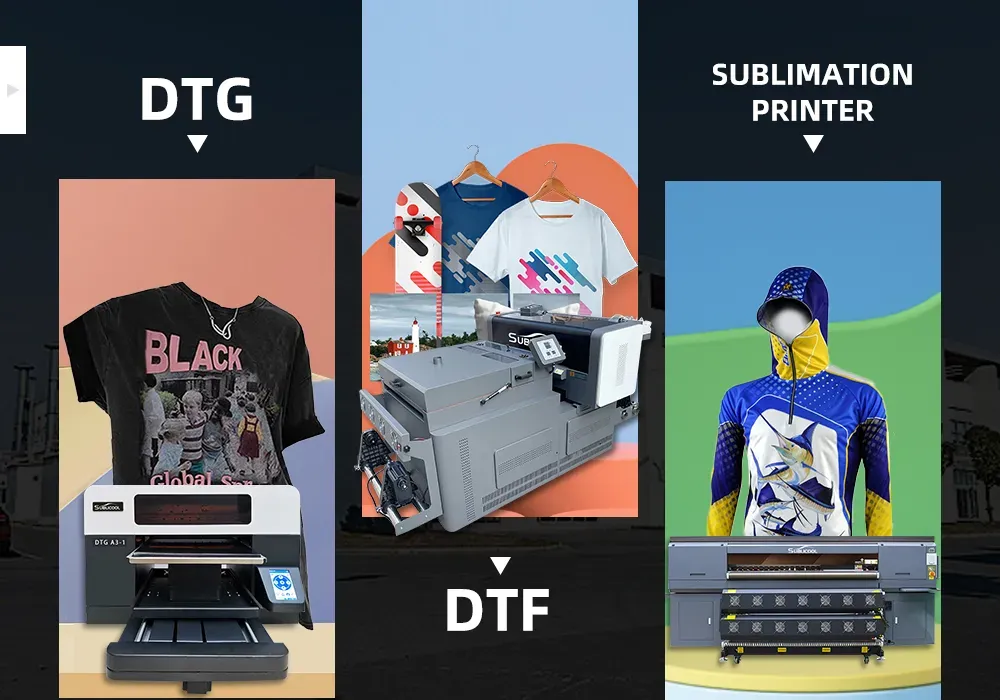DTF vs DTG vs sublimation stands at a crossroads for anyone printing apparel and gifts, since each path navigates different fabric behaviors, color outcomes, durability profiles, and production realities; for small businesses, choosing among these routes impacts not only product quality but also setup costs, lead times, and the ability to scale operations across categories. To choose wisely, you need a clear sense of how each method creates an image, adheres to fiber, and feels to the touch once cured and washed, as well as what the workflow looks like from design file to finished product, including considerations like color management, substrate testing, and real-world wear testing practices. DTF, for example, uses a film and bonding powder to transfer ink that can work across cotton blends and some synthetics, offering flexible workflows and robust color on a wide range of textiles, with relatively simple equipment requirements and consistent results across batch sizes. DTG, by contrast, prints directly onto fabric with water-based inks and usually shines on cotton with soft hand and meticulous edge definition, though it can require pretreatment and ongoing maintenance, which affects per-piece costs and sustainability of long-running campaigns; it also matters how much space the process will require, the maintenance cadence, and the supplier support you can count on over time. Sublimation optimizes all-over color on polyester and similar substrates, delivering vibrant, durable designs that become part of the fabric, but it is less forgiving on natural fibers and substrate limitations often shape project scope, making it ideal for all-over athletic wear and poly-based goods.
From an SEO and user perspective, these processes can be described as ink-transfer methods, garment-decoration techniques, or digital textile printing options, depending on the emphasis. Using these alternative terms helps search engines connect related concepts such as color fidelity, fabric compatibility, production efficiency, and post-print finishing. Think of the three paths as complementary approaches to embellishing fabric with graphics, each offering trade-offs in texture, drapability, and long-term performance.
DTF vs DTG vs sublimation: Quick method comparison for fabrics and finishes
DTF printing, DTG printing, and sublimation printing each offer distinct pathways to transfer designs onto textiles. Understanding how they differ in image creation, adhesion, and end-use feel helps you choose the right approach for your product mix. This is the classic printing method comparison that informs decisions about durability, fabric compatibility, and overall production flow.
In practice, the method you pick shapes color reproduction, texture, and wash durability. DTF printing tends to be versatile across fabrics, DTG printing shines with detailed, soft-hand imagery on cotton, and sublimation excels with vibrant all-over color on polyester. By weighing these strengths and limitations, you can tailor your approach to meet budget, speed, and quality goals.
DTF printing: versatility across fabrics and color reproduction
DTF printing uses a transfer film, bonding powder, and heat to move ink onto a garment. The process is designed to be flexible, enabling color-rich results on cotton, blends, and even some synthetics, without requiring fabric-specific pretreatments like DTG does. This makes DTF a practical option for shops that need a broad fabric footprint with a single workflow.
Color reproduction with DTF can be strong, especially on a variety of fabrics including darker items, where the film-based transfer helps maintain edge sharpness and saturation. While not always identical to direct-to-garment results on 100% cotton, DTF offers durable images and predictable performance across a mixed product line, supporting a lower per-piece cost at scale in many scenarios.
DTG printing essentials: detail, soft hand, and pre-treatment realities
DTG printing directly inks onto fabric, typically yielding ultra-fine detail and a notably soft hand on cotton garments. The process often relies on water-based inks and benefits from careful pre-treatment, especially on light-colored cotton, to achieve vibrant colors and crisp edges. This makes DTG a favorite for photographic imagery and designs with subtle gradients.
However, DTG can involve higher material costs per piece and longer setup times for small runs. Pre-treatment costs, maintenance, and potential fabric color limitations mean you’ll want to align DTG with high-detail art on cotton-rich fabrics and higher-end, soft-feel expectations for the final product.
Sublimation printing explained: all-over color on polyester and polymer-coated substrates
Sublimation printing leverages heat to embed dye into synthetic fibers, typically polyester, or polymer-coated substrates. The result is bright, durable color that becomes part of the fabric, creating an exceptionally smooth feel and edge-to-edge coverage ideal for all-over designs on performance wear and similar items.
A key constraint is substrate compatibility: sublimation performs best on polyester or polymer-coated materials and is not effective on most cotton fabrics. While color vibrancy and wash durability are standout advantages for polyester-based products, designers must plan around substrate limitations when projecting product lines and long-term wear properties.
Choosing the right method: practical decision framework
When selecting a method, evaluate fabric composition, production volume, design complexity, budget, and the desired finish. Sublimation tends to excel for all-over, high-saturation color on polyester, while DTG is strong for high-detail artwork on cotton with a soft hand. DTF offers a flexible, fabric-agnostic workflow suited to mixed substrates and varied product lines.
A pragmatic starting point is to test each method on your actual fabrics and designs. Consider a phased approach: begin with sublimation for all-over polyester items, use DTG for cotton-focused runs with detailed imagery, and deploy DTF for mixed-fabric projects. This testing mindset helps you map cost per piece, throughput, and quality to your brand goals.
Workflow, costs, and maintenance: optimizing production lines
Each method has its own upfront and ongoing costs, maintenance profiles, and workflow implications. Sublimation requires a heat press and a compatible printer with polymer-coated substrates, DTG demands a dedicated printer plus pretreatment and maintenance, and DTF centers on a standard printer with white ink, film, and bonding powder. Understanding these realities helps you design efficient production pipelines.
In terms of throughput and batch handling, sublimation can be highly efficient for large, all-over runs on polyester, while DTG offers strong detail for smaller cotton-focused batches with appropriate pretreatment. DTF often provides balanced throughput across fabrics, reducing fabric-specific bottlenecks and enabling a more flexible overall workflow.
Frequently Asked Questions
What are the fundamental differences between DTF printing, DTG printing, and sublimation printing?
DTF printing uses a transfer film with bonding powder to move ink onto fabrics, DTG printing prints directly onto the garment with water‑based inks, and sublimation printing dyes the fibers themselves (usually polyester) via heat. Each method differs in fabric compatibility, color behavior, hand feel, and durability, so the choice depends on your fabric mix and product goals.
In which scenarios should I choose DTF printing over DTG printing when working with mixed fabrics?
DTF printing offers broad fabric compatibility across cotton, blends, and some synthetics with a simpler workflow, while DTG often requires pretreatment on cotton and can be less predictable on blends. For mixed fabrics, DTF is typically the safer starting point due to versatility and consistent results.
What fabrics suit sublimation printing best, and when do DTF vs DTG offer better results?
Sublimation printing shines on polyester or polymer-coated substrates, especially for all-over, high-saturation designs. DTG excels on cotton-rich garments with intricate details and a soft hand when properly pretreated, while DTF provides strong color reproduction across a wider range of fabrics, including blends.
How do color vibrancy and hand feel compare across DTF vs DTG vs sublimation?
Sublimation on polyester typically delivers very bright, durable color with a smooth hand since color is embedded in the fabric. DTG on cotton can achieve rich colors and a soft hand with correct pretreatment, whereas DTF offers solid color on many fabrics but can introduce a bit more texture due to the transfer film, depending on settings.
What are typical costs and maintenance considerations when comparing DTF vs DTG vs sublimation?
DTG usually involves higher upfront costs (printers, pretreatment, and maintenance) and ongoing materials, while DTF often has lower per-piece costs and a simpler upkeep with film, resin, and powder. Sublimation requires a heat press and compatible sublimation inks and substrates; overall costs depend on volume, throughput, and fabric mix.
What practical decision framework should a small business use to pick between DTF vs DTG vs sublimation?
Test with real garments and designs across your typical fabrics, consider order size, finish desired, and budget. For all-over polyester prints, start with sublimation; for detailed cotton artwork, evaluate DTG after pretreatment; for mixed fabrics and flexible workflows, DTF can be the best starting point, with room to add another method later as demand grows.
| Aspect | DTF | DTG | Sublimation |
|---|---|---|---|
| Process overview. | DTF uses a transfer film with bonding powder, cured and then heat-transferred to fabric. It yields a durable image across a wide range of fabrics. | DTG prints directly onto fabric with water-based inks; often requires pre-treatment for cotton and excels on detailed images on light garments. | Sublimation uses heat to embed dye into polyester fibers (or polymer-coated substrates); colors become part of the fabric and offer all-over coverage. |
| Fabric compatibility. | Versatile across cotton, blends, and some synthetics. | Best on cotton and cotton blends (with pretreatment for vibrant results). | Optimized for polyester and polymer-coated substrates. |
| Image quality & color behavior. | Good color reproduction on a wide range of fabrics; strong on blends, with color managed via film transfer. | High-detail, photographic imagery on cotton when properly pre-treated; color can vary with fabric and ink system. | Bright, saturated colors on polyester; embedded color enables smooth gradients and edge clarity. |
| Hand feel. | Often a slight texture from the transfer film; texture can be more noticeable on darker garments. | Very soft hand when properly cured and pre-treated on cotton. | Very smooth hand; color is embedded in the fabric for a flat feel. |
| Durability & wash. | Durable across many fabrics with proper curing and heat transfer. | Durable when properly cured and pre-treated; performance depends on fabric type. | Excellent wash durability on polyester; color is embedded for lasting vibrancy. |
| Setup, costs & maintenance. | Relatively flexible: standard printer, bonding powder, and film; moderate initial costs. | Higher upfront costs for dedicated printers, pretreatment, and ongoing maintenance. | Requires a heat press and sublimation printer; ongoing substrate supply; typically lower per-piece costs at scale. |
| Best-use scenarios. | Mixed fabrics and broad fabric compatibility; good for versatile workflows. | High-detail artwork on cotton and cotton blends; ideal for photos on light garments. | All-over, vibrant color on polyester; ideal for performance wear and full-coverage designs. |
| Limitations. | Texture on darker fabrics can be more noticeable; color matching requires calibration. | Not ideal on non-cotton fabrics without pretreatment; best on light to white fabrics for vivid details. | Limited to polyester or polymer-coated substrates; not suitable for all materials without alternatives. |
| Practical workflow notes. | Film-based workflow with drying, bonding powder, and heat transfer—works across fabrics. | Pretreatment steps and ink maintenance; workflow scales with batch size. | Substrate preparation (polyester) and heat-press timing are key to maximizing results. |
Summary
DTF vs DTG vs sublimation are three robust paths to apparel and gift printing, each with its own cost, durability, fabric compatibility, and final feel. The right choice depends on your fabrics, design needs, production volume, and budget. Sublimation excels for all-over polyester designs, DTG delivers high-detail artwork with a soft hand on cotton when pre-treated, and DTF offers fabric flexibility and scalable production across mixed substrates. Start with one method to validate your workflow, then expand as demand grows. Through careful testing, calibration, and process optimization, you can select the method that best aligns with your product goals and brand vision.



